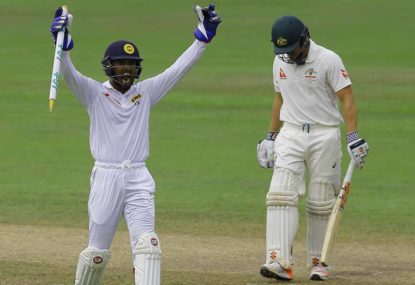Rank turners and green seamers – Australia’s batting failures on such bowler-friendly surfaces have become all-too-familiar in recent years.
Yet the pitches on which their batsmen have floundered in their past four Tests in Asia – two in Pakistan and now two in Sri Lanka – have been by no means spinners’ paradises.
The Galle deck on which Australia have capitulated in the ongoing second Test against Sri Lanka has not offered much help to any of the bowlers.
It is a million miles away from being the kind of raging turner which the Australians so fear. The same was true of the deck at Kandy for the first Test where only left arm wrist spinner Lakshan Sandakan earned consistently sharp turn.
And in the UAE just under two years ago the pitches were lifeless and brimming with runs. Those surfaces at Abu Dhabi and Dubai gave nothing to the pacemen and apart from the occasional delivery by Pakistan leg spinner Yasir Shah, there was minimal turn.
In spite of such relatively batting-friendly conditions, Australia repeatedly have capitulated with yesterday’s display of ineptitude perhaps the most galling. In total, 21 wickets fell yesterday, including 11 Australians.
Only six times in the past 60 years of Test cricket have more wickets fallen in a single day.
Such a stat would prompt the casual observer to assume the pitch was all but unplayable.
The reality is that local pundits and commentators stated the Galle pitch was in fact turning less than it had in recent Tests there.
The Australian pacers were fantastic in helping dismiss Sri Lanka twice for totals which were well below par. In the first innings they rolled the hosts for 281, when the average score batting first in Galle had been 375 over the past five Tests at the ground. Second time around they scythed through Sri Lanka’s top six, reducing them to 6-121.
But their lack of rest between innings meant the Australian quicks always were going to tire as the day wore on.
Sri Lanka’s tail duly wagged against the struggling Australian spin duo of Nathan Lyon and Jon Holland.
Lyon again fell into the trap of bowling too swift and flat in Asia. While Sri Lankan finger spinners Rangana Herath and Dilruwan Perera were quite slow through the air, averaging 81kmh and 82kmh respectively, Lyon fired his deliveries in at an average of 86kmh.
Not only did he bowl too fast but Lyon’s length often was too short, allowing the Sri Lankan batsmen to play him comfortably off the back foot. The contrast again was clear against Herath and Perera whose fuller lengths constantly had the Australian batsmen reaching for the ball.
Holland, meanwhile, was attacked by the Sri Lankan batsmen whenever he was handed the ball. Unable to deal with this pressure he lost the accuracy for which he has become known at State level.
It is not the fault of the bowlers, though, that Australia find themselves staring at a second consecutive crushing loss.
Mitchell Starc, Josh Hazlewood and Nathan Lyon have combined for the sensational figures of 33 wickets at an average of 20 in this series. Nothing more can be asked of a visiting bowling unit on what have been two fairly flat pitches.That trio must be hopeful their batting colleagues stop wasting their fine work.
Spin, flight, and ones that go straight
As expected, it is spin which has been the biggest challenge for the Australian batsmen this series.
Between them, Herath, Perera and Sandakan have snared 29 wickets at 13 across these two Tests. Few of their wickets have been the result of sharp turn or startling bounce. Often it has been straight deliveries which have brought the Australians undone, just like in the UAE in 2014.
Although the pitches have not been playing any tricks, most of Australia’s batsmen have looked panicked against spin. They have tended to occupy the extreme ends of the batting spectrum – either playing ultra-defensively, or batting in a cavalier fashion.
None of the Australians have been able to find the happy middle ground between these two approaches, aside from Steve Smith in the second innings at Kandy.
Meanwhile, the Sri Lankan batsmen have used their feet and the sweep shot to continually knock Australia’s spinners off their lengths. Even tail enders like Herath have swept effectively, something none of the Australians have managed.
The Sri Lankans use their feet and the sweep not only as a means of hitting boundaries, but for getting off strike.
The inability to rotate the strike and ease pressure has been a huge issue for the Australians. Spinners love nothing more than joining the dots against an unassertive batsmen, safe in the knowledge that eventually the building pressure will get to them.
Herath has done this expertly. Rarely in these two Tests has the crafty left armer produced unplayable deliveries which have turned or bounced alarmingly. Instead he has craftily managed his patience, waiting for the Australian batsmen to implode.
His success, and the related failures of the Australian batsmen, have had absolutely nothing to do with the pitches.





























































































